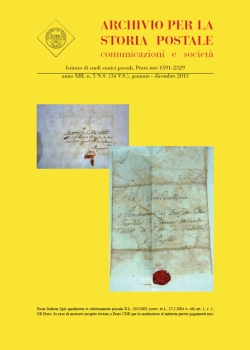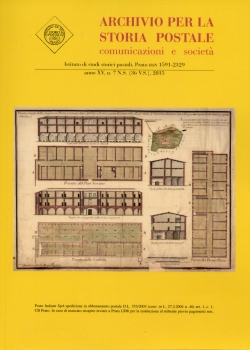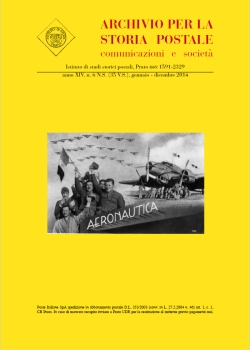Archivio per la storia postale N. 6 (35), gennaio-dicembre 2014, € 20,00
Indice
Andrea Giuntini, EditorialeLa guerra in posta. Mobilitazione, consenso e prigionia. Un caso studio
Graziano Mamone, Università di Genova, calandre2000@libero.it
Title
War in letters. Mobilization, consensus and captivity. A case study.
Parole chiave
Seconda guerra mondiale. Aeronautica. Albania. Internati militari italiani. Corrispondenza di militari.
Keywords
Second World War. Air Force. Albania. Italian prisoners of war. Military mail.
Riassunto
Svolto con la corrispondenza di Osvaldo Muratore, aviere italiano prima di stanza in Albania poi internato militare in Germania, lo studio affronta il tema del suo uso della corrispondenza per trasmettere in modo diretto o indiretto le proprie considerazioni e ostentare o contenere i propri stati d’animo, dall’adesione patriottica alla resistenza.
Abstract
This study examines the correspondence sent by the Italian airman Osvaldo Muratore during the Second World War. It spans Muratore’s wartime service, first in Albania and later as a prisoner of war in Germany. Muratore’s correspondence provides us with a rare glimpse of the myriad ways – sometimes overt, sometimes covert – in which contemporaries used the mail to communicate their feelings, and to reveal, or hide, their attitudes toward the war: from enthusiastic support to muffled resistance.
La Pirelli e la telegrafia sottomarina italiana
Andrea Giuntini, Università di Modena Reggio Emilia, giuntini@unimore.it
Title
Pirelli and the Italian submarine telegraphy.
Parole chiave
Telegrafia sottomarina. Giovanni Battista Pirelli. Emanuele Jona. Eastern Telegraph Co.
Keywords
Submarine Telegraphy. Giovanni Battista Pirelli. Emanuele Jona. Eastern Telegraph Co.
Riassunto
Il settore telegrafico marino fu il primo complesso scientifico-industriale per i legami che si instaurarono fra ricerca e applicazione pratica. Fu necessaria la costituzione di apposite grandi imprese, che operarono con una logica multinazionale. In quest’ambito operò anche G.B. Pirelli (1848-1932), che negli anni Ottanta dell’Ottocento entrò nel settore attuando proprie strategie, firmando convenzioni con l’Italia e avvalendosi dei servigi del più importante tecnico dell’epoca, Emanuele Jona. Pose cavi in Italia, nel Mediterraneo e nel mar Rosso, acquisendo una posizione di preminenza anche internazionale, grazie all’alleanza con la britannica Eastern Telegraph.
Abstract
The submarine telegraph (or cable) sector deserves to be recognized as the first industrial-scientific complex, since it was here that enduring linkages were first established between scientific research and their practical application. These linkages owed much to the establishment of giant corporations that operated on a multinational scale. Among the key figures in the late nineteenth-century submarine telegraph sector was the Italian industrialist G.B. Pirelli (1848-1932). Pirelli worked closely in this period with the Italian government and the submarine telegraph engineer Emanuele Jona to lay cables in the coastal waters of Italy, the Mediterranean Sea, and the Red Sea. In so doing, he acquired an international reputation that was burnished by his partnership with the British Eastern Telegraph Company.
I primi francobolli calcografici italiani
Bruno Crevato-Selvaggi, Istituto di studi storici postali, bruno.crevatoselvaggi@tin.it
Title
The first italian recess printed stamps.
Parole chiave
Emilio Diena. Calcografia. Francobolli tipo Michetti. Officina carte-valori, Torino.
Keywords
Emilio Diena. Recess printing. “Michetti” stamps. Security printing works, Turin.
Riassunto
Una lettera inedita di Emilio Diena offre nuove informazioni sui francobolli italiani tipo «Michetti» del 1906, 1909 e 1911.
Abstract
An unpublished letter from Emilio Diena gives new information on the Italian “Michetti” stamps of 1906, 1909 and 1911.
Notiziario
Pubblicazioni dell’Istituto




